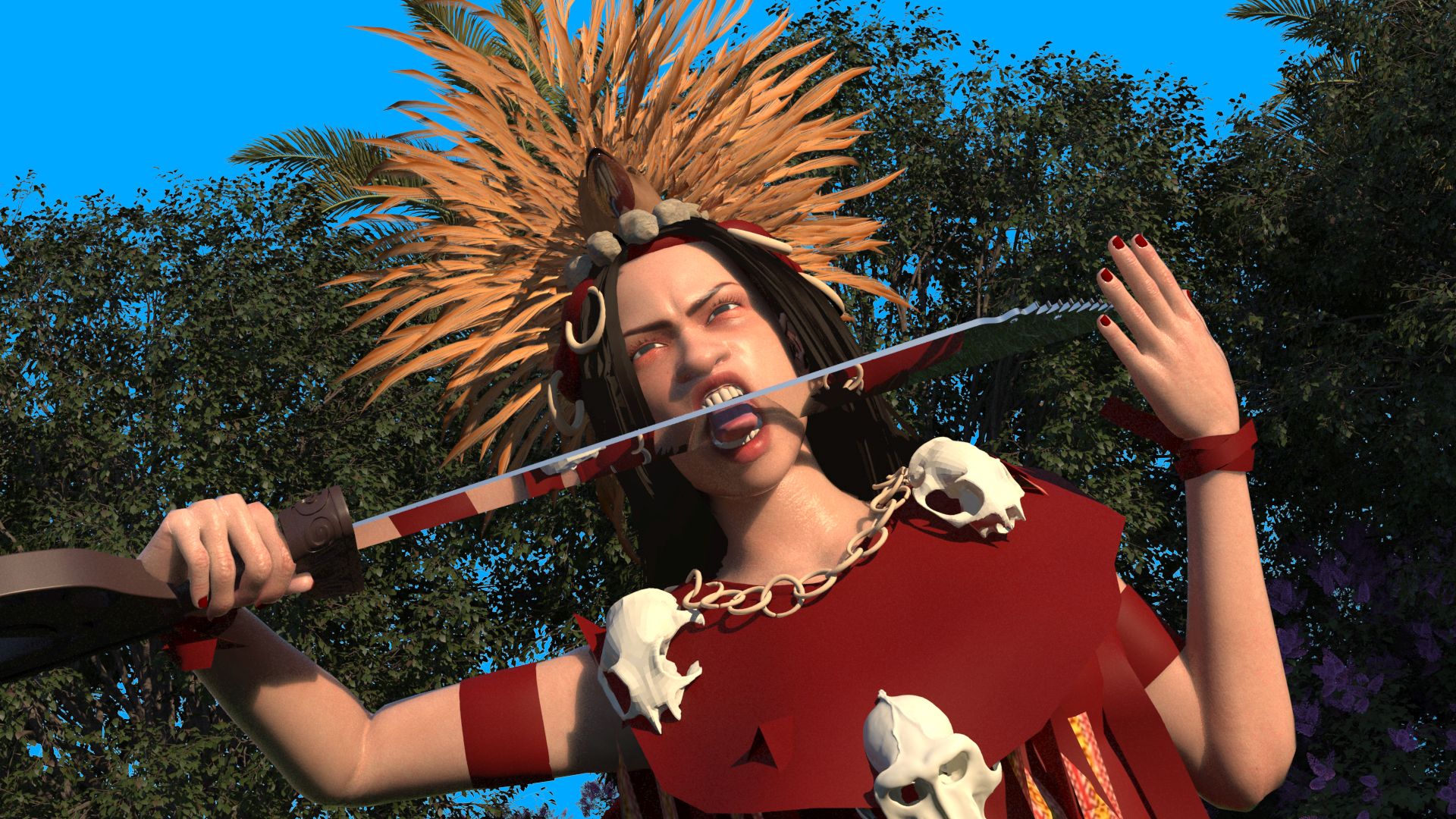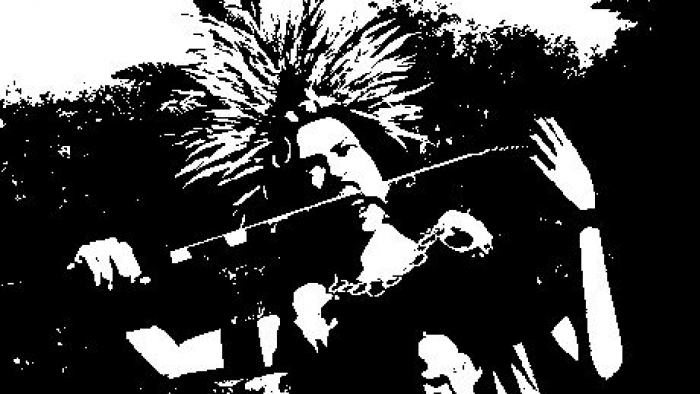Artist-in-Residence: Interview with Natasha Tontey
Artist-in-Residence: Interview with Natasha Tontey
Natasha Tontey is an artist and graphic designer based in Yogyakarta. Her work employs fiction as a method of speculative thinking. Through her artistic practice, she investigates how fear, horror, and terror could be manifested in order to control the public. Currently, Tontey is part of transmediale’s Artist-in-Residence programme. Her residency is supported by the Martin Roth-Initiative. Throughout her residency, Tontey is developing a new film — The Epoch of Mapalucene. The film explores the dynamics of the Minahasa worldview through the perspective of digital culture, speculating on its potential for imagining an alternative society based on a reciprocity that brings together animate and inanimate realms. Located in the Indonesian province of North Sulawesi, the stone-revering Minahasa are organised according to the gift economy of Mapalus, which was based on volunteerism, kinship with nature and mutual aid. The Epoch of Mapalucene is commissioned by transmediale with the support of the Martin Roth-Initiative and will be installed for the first time in the exhibition of transmediale 2021–22.
TM: Myth, speculation, fear, and ritual are recurring themes in your work. How do they manifest in what you are developing during your residency?
NT: Initially, I wanted to develop a work based on the Pinawetengan stone pact of the Minahasans, an ethnic group from North Sulawesi, Indonesia, about how humans build connection with non-human entities. But as I reflected on this agreement based on the stone, I found that it’s about more than just a human–non-human relation: the stone determines their practice of commoning land. No one talks about this importance. I also wanted to research the ancestral knowledge that I have known since I was a child but never paid that much attention to, in order to rethink my position as a diasporic Minahasan. When I visited the Pinawetengan stone, witnessed the stone ritual, and participated in other ancestral rituals, I knew that these practices have been misunderstood by many as a heresy, as an ancient practice that shouldn’t exist in the “modern” world. What makes them threatening to the Christian majority in North Sulawesi, which is one of the biggest Christian communities in the vastly Islamic majority of Indonesia? This leads me to think that historical artefacts have been constructed in popular belief as taboo, which further marginalises the Indigenous people of the region. In my residency, I try to develop a different way of seeing the ritual: the relation between the authorities that control reality by fabricating history and the resistance of the Indigenous community.
TM: Can you expand on the centrality of stone in the Indigenous practices, cosmological thinking, and political systems of the Minahasa, and their relation to your work?
NT: Once I had gotten really into Minahasan cosmology, I found that their story is not heteronormative or Darwinian (“survival of the fittest”) at all. This is evident in how they treated stone. At the same time, since Minahasan people have also experienced colonial presence, many of their cosmological ideas are intermixed with practices of modernity. At first, stone was conceived as a source of knowledge because it divides lands; in this way it created a political system for Minahasans. However, during Dutch colonialism, land – along with labour – was seen as a determinant for value. This entanglement of knowledges, cosmological and modern, is something that I am keen to explore in my work.
TM: As a social currency, the concept of Mapalus is the foundation of Minahasa’s gift economy, where transactions are based on trust and reciprocity. What does the concept of Mapalus embody in your view, and what socio-economic or cultural alternatives does it offer?
NT: In Indonesia, as a sovereign nation state with 633 recognised ethnic groups, there are actually many similar concepts to Mapalus. The Indonesian government uses the Javanese concept of reciprocity gotong royong as its nation-building philosophy. Mapalus differs from gotong royong, as the latter is not necessarily based on an obligation to be reciprocal. In the sub-ethnic group of the Toulour, there is the economic and cultural principle of Tamber, which refers to any altruistic activities in which someone gives something without an expectation to get something in return. This then becomes quite complex, as technically Tamber is also a part of Mapalus; the Toulour people see Tamber as a form of absolute Mapalus. So, although Mapalus is in some aspect a concept of mutual aid, some sub ethnic-groups understand it as more than that – as an act of true gift. This is what Mapalus offers as an alternative to our current economic system, which is mostly extractive and based on accumulation. Further, Indigenous Minahasan practices show that food sovereignty does not need to be determined by possession, property, and money, but, here, how the Minahasan people interact and communicate with their surroundings, kin, and nature.
TM: Your work for transmediale takes the form of a video installation, combining 3D animation with stone sculptures and water. The sculptures represent Karema and Lumimuut – a goddess and her daughter from Minahasa mythology. In your work you change the traditional hierarchical order bringing Karema and Lumimuut to the fore. Can you tell us more about these figures and why you rearranged the old hierarchy?

TM: The Epoch of Mapalucene shows a 3D animation of Karema as a warrior, performing a ritual with a sword, mixed with footage shot in Minahasa of a ritual involving the sculpture, which also appears in the installation. What is the significance of such rituals, both in Minahasan culture and in your practice?
NT: I am particularly interested in investigating the relationship between gender roles and ancestral knowledge. The sacred ritual is performed by Waraney, roughly “knights”, while they do the Kawasaran dance. In modern-day Minahasa, this dance is rarely performed by women. Although “Kawasaran” etymologically means to protect the paddy, which also implies the notion of care, nowadays the dance looks quite masculine, with an almost war-cry aesthetic. It continues to be significant in terms of its impact on Minahasan identity. When I was doing my field research I had a hard time finding female Kawasaran dancers, and when I participated in rituals I encountered questions related to my role as a woman. Behind this heteronormative perspective, we see how ancestral knowledge, modernity, and colonial legacy are entangled. The narrative and ritual of the work centre Indigenous people of the region, land sovereignty, and how Minahasan people practiced Mapalus.
TM: With colonisation and policies of assimilation for the last 200 years, many Indigenous communities like the Minahasa have experienced their cultures and mythological associations to their lands being eroded. Indonesian governance plans that seek to manage the collective Indonesian archipelago as one generic community have been critiqued by the Minahasa. Can you tell us a little about these histories and contemporary Minahasan activism? How do the Minahasa refuse such policies and continue in their ways of life while living within Indonesian state?
NT: Politics in Minahasa vary: from people who practice the religion of colonial legacy against Indigenous beliefs, to liberals who always find a way to master nature, to the Indigenous community who simply try to protect the land and preserve ancestral knowledge. Discrimination towards the Indigenous community is manifest in how they are labelled as a primitive community, one that cannot catch up with the “progress” of the modern world. The founding fathers of Indonesia only see sovereignty as based on the assumption that everyone shares the same cultural roots. And since the country got its independence as a nation state, it is predominantly Java-centric. Many Minahasans refuse this centrism and Mapalus is a way for them to sustain their idea of decentralisation within the state. Current activism in Minahasa, which has mushroomed, focuses on the refusal of land policies and the importance of pushing the Indigenous bill, which, crucially, would give rights to nature.
TM: Fiction and speculation are powerful tools for imagining new worlds and instigating the change to bring them into being. At the same time, these artistic strategies can risk cynicism, disengagement, or disinformation. How do you respond to the fallacies of speculation within your practice?
NT: Immersion in the community seems essential – if there isn’t proper dialogue between the artist who speculates and the community, it doesn’t work. In my case, I built a strong relationship with the Indigenous Minahasan community in North Sulawesi. I told them my intention to reimagine Minahasan cosmology as an alternative to the current political and economic system of Indonesia. It’s also important for me to be quite critical in learning about and starting to understand the complex history and cosmology of Minahasa. I built my speculation from this critical overview, which I share, discuss, and review together with the community. Sure, there may still be a risk of fallacies, but if fiction could at some point be seen as disinformation, it also creates crucial dialogue and discussion. The Epoch of Mapalucene expands the notion of Mapalus as a counter-idea to this epochal existential risk that we face today.

TM: Most of your works emerge from questions that challenge current ways of living, particularly in relation to technology, human nature, and the future. Can you speak about the refusal of anthropocentrism, and how relations with the earth, stone, and sediment, as seen through Minahasan cosmology, can open up alternative worlds and new ways of being based on reciprocity?
NT: Engaging with Minahasan cosmology made me realise that there are many ways of thinking about life that are worlds apart from the anthropocentric modernity we have today. The existence of stone in Minahasan cosmology is not only for the sake of human extraction, or as material used by humans to develop technology, but it is an object that gives life itself. Stones give place for moss to exist, moss gives nutrition to other beings, which eventually leads to human existence. This chain reaction is important in Minahasan cosmology, which is also evident in the story of the cosmogony of Minahasa – how Lumimuut was born from stone. This same stone gives the possibility of dividing land. Seeing land as part of the cycle of life then leads to the notion of Mapalus and reciprocity. No one owns the land, but anyone could grow anything from the land. Stone provides a calculation of space, dividing land based on different crops, which is the basis for the Mapalus system. We can see how stone as an entity that existed before humans is conceived as the centre of Minahasan cosmology. And this really challenges the way we think about material: we shouldn’t just think of material as something we can extract, it also has a social life.


